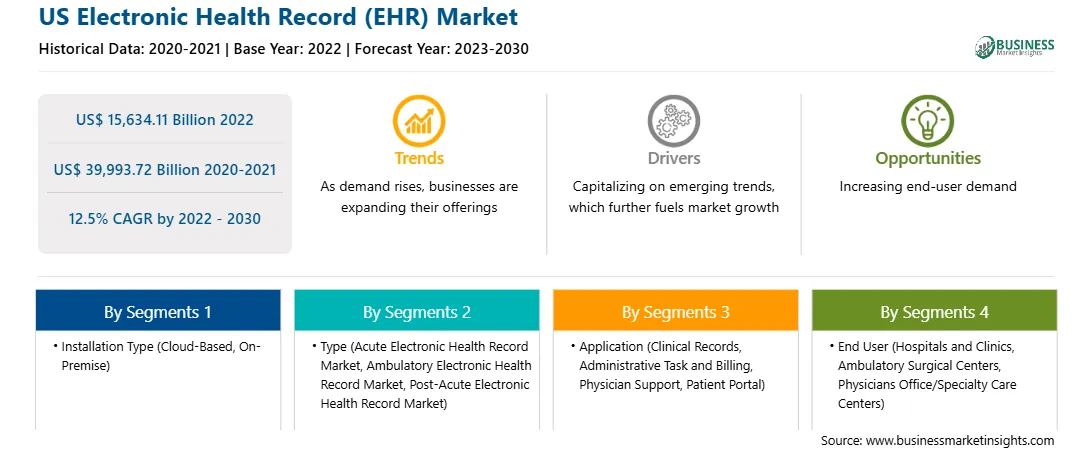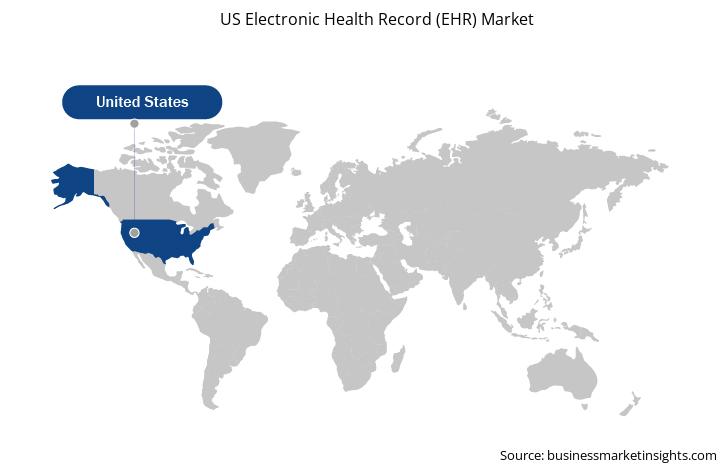The US Electronic Health Record market is expected to grow from US$ 15,634.11 billion in 2022 to US$ 39,993.72 billion by 2030; it is estimated to grow at a CAGR of 12.5% from 2022 to 2030.
The report highlights trends prevailing in the market and factors driving the market growth. The market growth is attributed to the increasing adoption of electronic health records, rising incentives by the federal government, and growing incidences of medication errors, which are driving the US Electronic Health Record market size and growth. Additionally, combining electronic health records with artificial intelligence and voice recognition is likely to emerge as a significant trend in the market during the forecast period. However, concerns regarding data privacy hinder market growth during the forecast period 2022-2030.
Rising Incentives by the Federal Government drive the market in the forecast period.
The government has invested billions in training health information technology workers and founding regional extension centers to provide technical advice. In 2009, as part of the Health Information Technology for Economic and Clinical Health (HITECH) Act, the federal government reserved US$ 27 billion for an incentive program that inspires hospitals and providers to implement Electronic Health Records systems that would enable the health data historically confiscated in paper files to be shared among providers and use to improve the healthcare quality.
The Medicare Electronic Health Record Incentive Program is governed by the Centers for Medicare & Medicaid Services (CMS). In the US, the Medicare and Medicaid Electronic Health Records Incentive Programs offer incentives to hospitals, physicians, and other healthcare facilities for meaningful use of certified Electronic Health Records technology. A qualified professional or hospital can get a maximum incentive amount of up to US$ 63,750 through the Medicaid Electronic Health Records Incentive Program and up to US$ 44,000 through the Medicare Electronic Health Records Incentive Program. This incentive program succeeded in inspiring many healthcare facilities to adopt Electronic Health Records systems.
Combining Electronic Health Records with Artificial Intelligence and Voice Recognition is the upcoming market trend.
Voice recognition technology is an excellent asset for Electronic Health Records systems as it helps clinicians enter information and patient data hands-free. In addition, it reduces incorrectness and errors by dictating records in Electronic Health Records, which further accelerates the information recording process.
There is a track record of artificial intelligence transforming the healthcare sector by helping doctors recognize historical trends about the condition of a patient and make diagnoses. For instance, a physician would ask the Electronic Health Records system about the last recorded iron levels from a patient's blood test by using voice-enabled technology. After giving the instructions, the system will report to the doctors about the health status of the patient. This is a working example of how Northwell Health and Allscripts have already partnered to start developing AI-based, Voice-Enabled Electronic Health Records. It will be a beneficial system for providers with hectic work schedules. Further, Saykara has received a 2021 BIG Innovation Award for its AI voice assistant that produces clinical notes, orders, referrals, and more by ambiently listening to conversations between physicians and patients. The assistant "Kara" is accessible via a mobile app that extracts meaning and intent from what it hears and then populates both structured and narrative data in the electronic health records. Besides, Epic is in the process of developing an AI Electronic Health Records documentation assistant. Furthermore, Google is recruiting talent to help build artificial intelligence and voice recognition tools to improve the clinical documentation process and streamline Electronic Health Records workflows.
Report Segmentation and Scope -
The "US electronic health record market" is segmented on the basis of installation type, type, application, and end user. Based on installation type, the market is segmented into cloud-based and on-premise. In terms of type, the US Electronic health record market is divided into acute electronic health records, ambulatory electronic health records, and post-acute electronic health records. By application, the market is segmented into clinical records, administrative tasks and billing, physician support, and patient portals. Based on end users, the market is segmented into hospitals and clinics, physician's offices/specialty care centers, and ambulatory surgical centers.
The US electronic health record market, by installation type, is bifurcated into cloud-based and on-premise. The cloud-based segment held a larger share of the market in 2022 and is anticipated to register a higher CAGR of 12.7% during 2022-2030. A cloud-based electronic health record allows patient health files to be stored in the cloud rather than saved on the healthcare facility's internal servers. The collected data is organized and maintained in actionable and shareable formats to allow effective communication between healthcare providers, third-party payers, and patients. Cloud-based electronic health records are popular among physicians and healthcare providers operating on a smaller scale as these systems can be installed without any requirement for in-house servers and offer a wide range of customizations and improvements as per their needs. Cloud-based solutions are cost-effective as cloud computing decreases the cost of managing and maintaining IT systems. Cloud-based electronic health records offer flexibility and enable the user to access the data remotely.
Additionally, developments by market leaders in this segment are likely to improve the market growth. For instance, in July 2020, Cerner launched CommunityWorks Foundations, a cloud-based electronic health record platform, to reduce the cost of traditional electronic health record systems in rural and critical access hospitals. Similarly, in December 2020, Amazon's cloud division introduced a new tool, Amazon HealthLake, for healthcare organizations to search and analyze data.
The US is the largest market for electronic health records in North America. The transformation of digital healthcare majorly drives the market, the increasing number of chronic diseases, and support from the federal government to implement electronic health records in order to improve the quality of care. Other factors, such as the introduction of advanced software technologies in healthcare, a higher number of hospitals, and the implementation of strategic government policies, also aid in promoting the expansion of the US electronic health records market. Additionally, the need for automated systems due to the increasing patient population and crunch of healthcare resources are projected to fuel the adoption of electronic health records systems in the US. Emphasis on error reduction in hospital administrative work, which causes considerable mortalities, is also prominently anticipated to drive the growth of the market during the forecast period. For instance, as per a study published in the Journal of Patient Safety, an estimated 400,000 patient casualties are caused due to administrative errors in the US each year.
Companies in the US Electronic Health Record market adopt various organic and inorganic strategies. The organic strategies mainly include product launches and product approvals. Further, inorganic growth strategies witnessed in the market are acquisitions, collaborations, and partnerships. These growth strategies allow the market players to expand their businesses and enhance their geographic presence, thereby contributing to the overall market growth. Further, acquisition and partnership strategies help the market players strengthen their customer base and expand their product portfolios. A few of the significant developments by key players in the US Electronic Health Record market are listed below.
The Office of the National Coordinator for Health Information Technology (ONC), The New England Journal of Medicine, Definitive Healthcare, Johns Hopkins, HIPPA Journal, and the Healthcare Financial Management Association are a few of the major primary and secondary sources referred to while preparing the report on the US Electronic Health Record market.
Strategic insights for the US Electronic Health Record (EHR) provides data-driven analysis of the industry landscape, including current trends, key players, and regional nuances. These insights offer actionable recommendations, enabling readers to differentiate themselves from competitors by identifying untapped segments or developing unique value propositions. Leveraging data analytics, these insights help industry players anticipate the market shifts, whether investors, manufacturers, or other stakeholders. A future-oriented perspective is essential, helping stakeholders anticipate market shifts and position themselves for long-term success in this dynamic region. Ultimately, effective strategic insights empower readers to make informed decisions that drive profitability and achieve their business objectives within the market.

| Report Attribute | Details |
|---|---|
| Market size in 2022 | US$ 15,634.11 Billion |
| Market Size by 2030 | US$ 39,993.72 Billion |
| Global CAGR (2022 - 2030) | 12.5% |
| Historical Data | 2020-2021 |
| Forecast period | 2023-2030 |
| Segments Covered |
By Installation Type
|
| Regions and Countries Covered | United States
|
| Market leaders and key company profiles |
The geographic scope of the US Electronic Health Record (EHR) refers to the specific areas in which a business operates and competes. Understanding local distinctions, such as diverse consumer preferences (e.g., demand for specific plug types or battery backup durations), varying economic conditions, and regulatory environments, is crucial for tailoring strategies to specific markets. Businesses can expand their reach by identifying underserved areas or adapting their offerings to meet local demands. A clear market focus allows for more effective resource allocation, targeted marketing campaigns, and better positioning against local competitors, ultimately driving growth in those targeted areas.

The List of Companies -?
- Oracle Corp
- AltexSoft Inc
- Veradigm Inc
- Greenway Health LLC
- eClinicalWorks LLC
- Infor-Med Inc
- Microwize Technology Inc
- Athenahealth Inc
- ChipSoft BV
- CureMD.com Inc
- AdvancedMD Inc
- PracticeSuite?
The US Electronic Health Record (EHR) Market is valued at US$ 15,634.11 Billion in 2022, it is projected to reach US$ 39,993.72 Billion by 2030.
As per our report US Electronic Health Record (EHR) Market, the market size is valued at US$ 15,634.11 Billion in 2022, projecting it to reach US$ 39,993.72 Billion by 2030. This translates to a CAGR of approximately 12.5% during the forecast period.
The US Electronic Health Record (EHR) Market report typically cover these key segments-
The historic period, base year, and forecast period can vary slightly depending on the specific market research report. However, for the US Electronic Health Record (EHR) Market report:
The US Electronic Health Record (EHR) Market is populated by several key players, each contributing to its growth and innovation. Some of the major players include:
The US Electronic Health Record (EHR) Market report is valuable for diverse stakeholders, including:
Essentially, anyone involved in or considering involvement in the US Electronic Health Record (EHR) Market value chain can benefit from the information contained in a comprehensive market report.